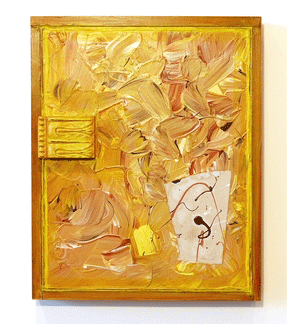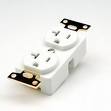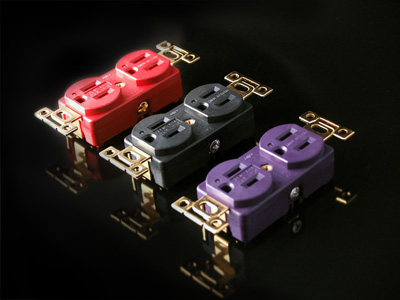Random Noise 17

Random Noise 17

Plugging into Oyaide Outlets,
Revisiting Acoustic Revive Cables,
Turbocharging an RR-77, and Local Chitchat
Oyaide: micro to macro swank
 Since I’ve gone so publicly gaga over the Acoustic Revive products I’ve covered, Lotus Group’s Joe Cohen thought I might like to evaluate Oyaide outlets. Delighted – one is always on the prowl – but I did explain that FIM 880 outlets provide for the audio system, four duplexes on discrete lines, and that I might not notice a difference. Joe wasn’t much put off by the warning. (Lotus Group USA is Oyaide’s American distributor as well as Acoustic Revive’s. The Acoustic Revive power cords and line conditioners I’m using include Oyaide hardware).
Since I’ve gone so publicly gaga over the Acoustic Revive products I’ve covered, Lotus Group’s Joe Cohen thought I might like to evaluate Oyaide outlets. Delighted – one is always on the prowl – but I did explain that FIM 880 outlets provide for the audio system, four duplexes on discrete lines, and that I might not notice a difference. Joe wasn’t much put off by the warning. (Lotus Group USA is Oyaide’s American distributor as well as Acoustic Revive’s. The Acoustic Revive power cords and line conditioners I’m using include Oyaide hardware).
Joe sent me four Oyaide duplexes in descending order of price:
 Two R-1 Berylliums at $145 each; one SWO-XXX Ultimate at $99; and one SWO-GX+ Ultimate at $95. The FIM 880 duplexes are in this approximate range ($80-$110). As to how the Oyaide models differ: The 20-amp-capable, white R-1 Beryllium features beryllium copper contacts plated in platinum and palladium.
Two R-1 Berylliums at $145 each; one SWO-XXX Ultimate at $99; and one SWO-GX+ Ultimate at $95. The FIM 880 duplexes are in this approximate range ($80-$110). As to how the Oyaide models differ: The 20-amp-capable, white R-1 Beryllium features beryllium copper contacts plated in platinum and palladium.
Wikipedia: “Beryllium copper, also known as copper beryllium, BeCu or beryllium bronze, is a metal alloy of copper and 0.5 to 3% beryllium, and sometimes with other alloying elements, and has significant metalworking and operating performance qualities. Beryllium copper is a ductile, weldable, and machinable alloy. It is resistant to non-oxidizing acids (for example, hydrochloric acid, or carbonic acid), to plastic decomposition products, to abrasive wear and to galling. Furthermore, it can be heat-treated to improve its strength, durability, and electrical conductivity.”
Wikipedia, continued: “Palladium, along with platinum, rhodium, rethenium, iridium and osmium form a group of elements referred to as the platinum group metals (PGMs). Platinum group metals share similar chemical properties, but palladium has the lowest melting point and is the least dense of these precious metals. Palladium is also tarnish resistant, electrically stable and resistant to chemical erosion as well as intense heat.”

The 15-amp, grape-purple SWO-XXX Ultimate features polished phosphor bronze contacts plated in 1.5 microns of gold and 0.3 micron of palladium.
Wikipedia: “Phosphor bronze is an alloy of copper with 3.5 to 10% of tin and a significant phosphorus content of up to 1%. The phosphorus is added as a deoxidizing agent during melting. These alloys are notable for their toughness, strength, low coefficient of friction, and fine grain.”
The 15-amp, burgundy SWO-GX+ Ultimate features polished phosphor bronze contacts plated in gold. I guess we all know what gold is, so that’s it for the Wikipedia excerpts.
A gold-plated brass band with installation flanges enwraps the glass-infused PBT (Polybutylene Terephtalate) bodies of all three models. No martial music is involved, unless of course that’s what you want to play. As with the Oyaide terminations on the AR cables, fit and finish are first rate. As a matter of interest for those of you who live close to the sun, an Oyaide duplex’s PBT-glass body can withstand a temperature of 200 degrees centigrade.
So how does one go about evaluating these things? Milady and I live in an antique. While the wiring’s up to code, with my ten thumbs and vast fund of ignorance, I don’t mess with electrical anything. No, check that. I do change light bulbs and insert and pull plugs. If I instructed David, our affable electrician, to leave an FIM 880 in place, I’d have made at best flawed comparisons. One’s memory for less than gross differences in sound is among our species’ least reliable. By the time I unplugged and reconnected the CDP or amps, giving them a moment to return to fighting trim, too many minutes would have elapsed to form other than a vague impression. Further, I find these on-the-spot comparisons stressful. The immediately preceding, starting with my imaginary conversation with our electrician, is pure, no-beef baloney. The truth: I’d have had to pay David for another visit to remove and replace the remaining FIM 880 with an Oyaide outlet. Call me a skinflint, fine, but never late for dinner. Whatever, I’m a lot happier kicking back for a leisurely listen via these three Oyaide outlets and from that forming opinions.
 Lotus Group’s Joe Cohen thought I’d find the R-1 the most neutral. To remind, the heart of the system consists of three plug-ins: a pair of NuForce mono amps and an Integris CDP. I began with the CDP’s Power Tap in the R-1 behind the right speaker, the mono amps’ Power Tap in the R-1 behind the left speaker. The term “euphoria audiophilica” explains itself. The differences I heard transported me to a better place. Dimensionality! Transparency! Interstellar silence! The best highs this side of smack! And all this before a proper burn-in!
Lotus Group’s Joe Cohen thought I’d find the R-1 the most neutral. To remind, the heart of the system consists of three plug-ins: a pair of NuForce mono amps and an Integris CDP. I began with the CDP’s Power Tap in the R-1 behind the right speaker, the mono amps’ Power Tap in the R-1 behind the left speaker. The term “euphoria audiophilica” explains itself. The differences I heard transported me to a better place. Dimensionality! Transparency! Interstellar silence! The best highs this side of smack! And all this before a proper burn-in!
The mind-boggler is a disc I return to below, Carmina Burana, which, when played before the outlet swaps, seemed to show its age. Those period qualities I thought I once heard were nowhere within earshot. Glorious sound only! So, what do we have here, a bona fide epiphany or that not so rare emotional disorder, euphoria audiophilica? Let’s just say I survived the WOW! period intact and am able to proceed as a somewhat sane and rational reporter. I say “somewhat” in the understanding that a perfectly sane and rational reporter, as certified by a panel of psychiatrists, would piss himself laughing at the notion that outlets make a difference in how a system sounds. But he wouldn’t be an audiophile.
As to how far one needs to go in achieving better sound, received AES wisdom (for example) tells us that a well-made outlet with a secure grip – for example, an outlet rated as hospital-grade – is all one needs. You doubtless took note of the models I’ve been sent with respect to metals and platings. My task is to decide whether I can hear differences. Obviously, Oyaide thinks I should be able to. Also, as a matter of metallurgical synergy, perhaps there’s something to be said for mating Oyaide plugs with Oyaide outlets. Etcetery, etcetery. This is all off the top of my impressionable head. One can speculate till the cows come home, but ultimately, the ears tell the story.
 For my test track, I settled on a performance that allows me to pick up on subtle to obvious differences: Naxos 8.557507, a Stravinsky program conducted by Robert Craft, the composer’s long-time aide and right-hand man. A work from 1938, the Concerto in E flat, “Dumbarton Oaks,” for ten strings, flute, clarinet, bassoon and two horns, was recorded in 1992 at SUNY, Purchase, NY by the excellent Gregory Squires. (Craft’s fine note don’t mention that Dumbarton Oaks, an estate in Washington, DC, was the site of a conference in 1944 that led to the formation of the United Nations.) The spacious, richly detailed, dynamically subtle image Squires achieved makes this an ideal vehicle. And the music’s a pleasure.
For my test track, I settled on a performance that allows me to pick up on subtle to obvious differences: Naxos 8.557507, a Stravinsky program conducted by Robert Craft, the composer’s long-time aide and right-hand man. A work from 1938, the Concerto in E flat, “Dumbarton Oaks,” for ten strings, flute, clarinet, bassoon and two horns, was recorded in 1992 at SUNY, Purchase, NY by the excellent Gregory Squires. (Craft’s fine note don’t mention that Dumbarton Oaks, an estate in Washington, DC, was the site of a conference in 1944 that led to the formation of the United Nations.) The spacious, richly detailed, dynamically subtle image Squires achieved makes this an ideal vehicle. And the music’s a pleasure.
Listening to the system and its tweaks via R-1 outlets, I became increasingly delighted with what seemed to me an uptick in resolution, soundstaging, micro-dynamics, background silence, air – what we audiophiles live for. Very nice, lovely in fact, but impressions remain unreliable until the reporter can make what at least approaches a reasonable comparison. With the Integris CDP as my guinea pig (the amps remaining with the Power Tap connecting to an R-1), the first switch was to the SWO GX+, the duplex with the gold-plated phosphor-bronze contacts.
There’s no mistaking the difference. The SWO GX+ sounds more lush than the better-resolving R-1. I also hear a touch of graininess. I know, I know – I’m being predictable. I decide in favor of the pricier item. Believe me, were it the other way around, I’d say so. I’ve nothing to gain or lose by expressing a preference. And I’m not in the least reluctant to tell you how amazed I am. I installed the FIM outlets in the loosely held hope they’d do some good. It was an audiophile thing. On faith, as it were.
Faith need not apply just now. Nothing vague about it. This Oyaide adventure’s been an ear-opener. Also, given what we audiophiles spend on gear, the difference between $90 and $145 per duplex falls low on the mad-money index.
At four bucks more than the SWO GX+ Ultimate, the SWO XXX Ultimate (three x’s for especially explicit?) comes closer to the R-1 in those qualities this listener cherishes. The phosphor bronze’s plating of gold and palladium perhaps contributes to the duplex’s superior neutrality. Harmonic textures are quite lovely in a way that differs from SWO GX+’s florid character.
And I keep reminding myself I’m writing about how outlets sound! Please! Someone! Restore my innocense!
The SWO XXX Ultimate strikes me as the slightest bit darker than the R-1, and it doesn’t present as exquisitely detailed a soundstage. So it’s the R-1 by a length-and-a-half. I’m grateful to Oyaide for the education. I’ll be reporting on an Oyaide power cord, probably in the next Random Noise.
To close on an expression of mild puzzlement followed by an expression of mild contrition: my impression of the R-1’s superiority raises an interesting issue. If the price spread were greater, I’d understand the existence of like products from one manufacturer. Cable makers do this routinely. Oyaide has scored so resoundingly with the R-1 that I see little need or raison d’être for other outlets in the company’s extensive product line.
I emailed the above opinion to Joe Cohen, who set me straight. Vis-à-vis the R-1, the SWO Ultimate outlets are quite popular – often preferred, in fact. The best seller among Japanese audiophiles is the SWO-DX, which I’ve not had the chance to use. Can’t say this too often: system dependency. At least I was able to demonstrate (to myself) that outlets produce sonic consequences.

![]()
Don’t forget to bookmark us! (CTRL-SHFT-D)
2 thoughts on "Random Noise 17"
Leave a Reply
Stereo Times Masthead
Publisher/Founder
Clement Perry
Editor
Dave Thomas
Senior Editors
Frank Alles, Mike Girardi, Russell Lichter, Terry London, Moreno Mitchell, Paul Szabady, Bill Wells, Mike Wright, and Stephen Yan,
Current Contributors
David Abramson, Tim Barrall, Dave Allison, Ron Cook, Lewis Dardick, John Hoffman, Dan Secula, Don Shaulis, Greg Simmons, Eric Teh, Greg Voth, Richard Willie, Ed Van Winkle, Rob Dockery, Richard Doran, and Daveed Turek
Site Management Clement Perry
Ad Designer: Martin Perry





There is no “Next Page” at the link provided
Hi Jason,
We apologize for losing some of our reviews while upgrading the site.